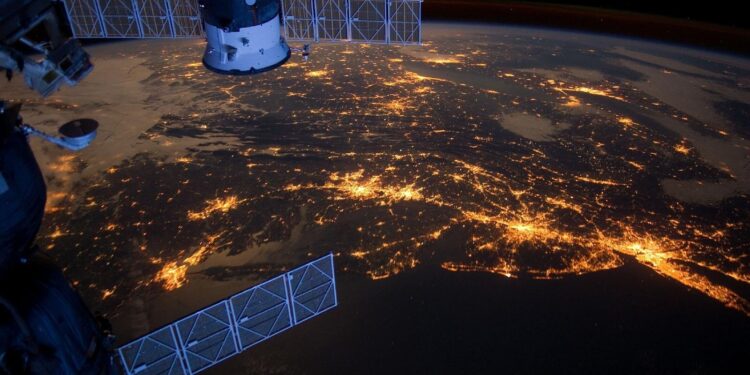Credit: CC0 Public Domain
Low-orbit satellites could soon provide millions of people around the world with access to high-speed communications, but the satellites’ potential is limited by a technological limitation: Their antenna arrays can handle only one user at a time.
The one-to-one ratio means that companies must launch either constellations of many satellites or large individual satellites with many networks to provide widespread coverage. Both options are expensive, technically complex and could lead to crowded orbits.
SpaceX, for example, has opted for the “constellation” formula. Its network, StarLink, currently includes more than 6,000 satellites in low orbit, more than half of which have been launched in recent years. SpaceX plans to launch tens of thousands more in the coming years.
Researchers at Princeton University and Yang Ming Chiao Tung University in Taiwan have invented a technique that allows low-orbit satellite antennas to handle signals from multiple users at once, dramatically reducing the hardware needed.
In a paper titled “Physical Beam Sharing for Communications with Multiple Satellites in Low Earth Orbit” published June 27 in IEEE Transactions on Signal ProcessingThe researchers describe a method to overcome the single-user limitation. The strategy builds on a common technique for boosting communications by positioning antenna arrays to direct a beam of radio waves precisely where it is needed.
Each beam carries information, such as text messages or phone calls, in the form of signals. While antenna arrays on ground-based platforms such as cell towers can handle multiple signals per beam, low-orbit satellites can only handle one.
The satellites’ 20,000-mile-per-hour speed and constantly changing positions make it nearly impossible to manage multiple signals without mixing them up.
“For a cell phone antenna to communicate with a car going 60 miles per hour on the highway, relative to the speed at which data is being exchanged, the car isn’t moving very much,” said H. Vincent Poor, co-author of the study and Michael Henry Strater Professor of Electrical and Computer Engineering at Princeton University. “But these satellites are moving very fast to stay up there, so the information about them changes rapidly.”
To address this limitation, researchers have developed a system to efficiently split transmissions from a single antenna array into multiple beams without requiring additional hardware. This allows satellites to overcome the limit of a single user per antenna array.
Shang-Ho (Lawrence) Tsai, co-author and professor of electrical engineering at Yang Ming Chiao Tung University, compared the approach to shining two separate beams from a flashlight without the need for multiple bulbs. “Now we only need one bulb,” he said. “That means a huge reduction in cost and energy consumption.”
A network with fewer antennas could mean fewer satellites, smaller satellites, or both. “A conventional low-Earth orbit satellite network might need 70 to 80 satellites to cover the United States alone,” Tsai said. “Today, that number could be reduced to maybe 16.”
Poor said the new technology can be integrated into satellites that are already built. “But one of the main advantages is that it allows for a simpler satellite design,” he added.
Impacts in space
Low-orbit satellites are located in the lower layer of Earth’s atmosphere, between 100 and 1,200 miles (160 and 2,000 kilometers) above the surface. This region of space offers limited space. The more objects there are in the air, the more likely they are to crash, break up, and release small fragments of debris that can then crash into other objects.
“The concern is not so much about being hit by a falling satellite,” Poor said, “but rather whether the long-term future of the atmosphere and orbit could be clouded by space debris that could cause problems.”
As the low-orbit satellite industry gains traction at a rapid pace, with companies like Amazon and OneWeb deploying their own satellite constellations to provide internet services, the new technique has the potential to reduce the risk of these dangers.
Poor said that while the paper is purely theoretical, the efficiency gains are real. “This paper is all based on mathematics,” he said. “But in this particular field, theoretical work tends to be very predictive.”
Since publishing his paper, Tsai has conducted field tests using underground antennas and demonstrated that the calculations do indeed work. “The next step is to implement this principle in a real satellite and launch it into space,” he said.
More information:
Yan-Yin He et al., Physical beam sharing for communications with multiple low-orbit satellites, IEEE Transactions on Signal Processing (2024). DOI: 10.1109/TSP.2024.3408061
Provided by Princeton University
Quote:New method could reduce number of satellites needed for global coverage (2024, September 13) retrieved September 13, 2024, from
This document is subject to copyright. Apart from any fair dealing for the purpose of private study or research, no part may be reproduced without written permission. The content is provided for informational purposes only.



